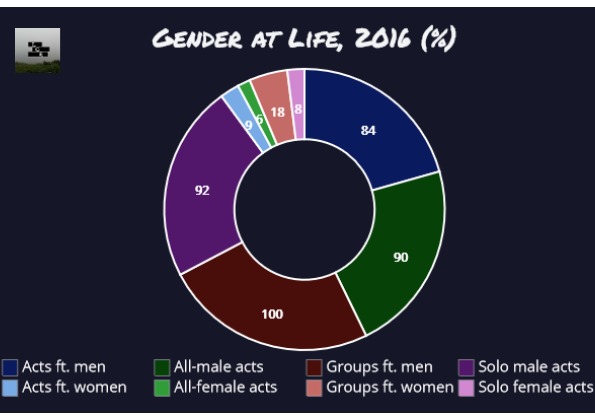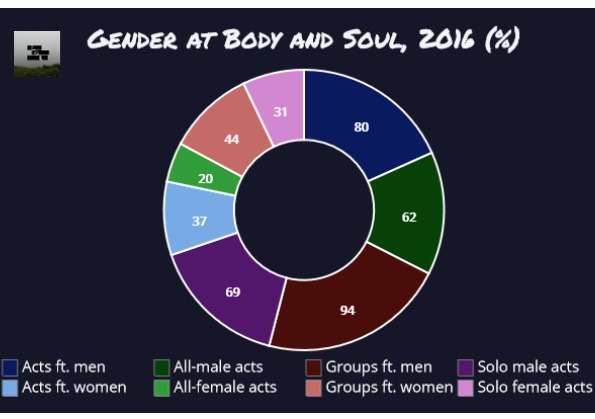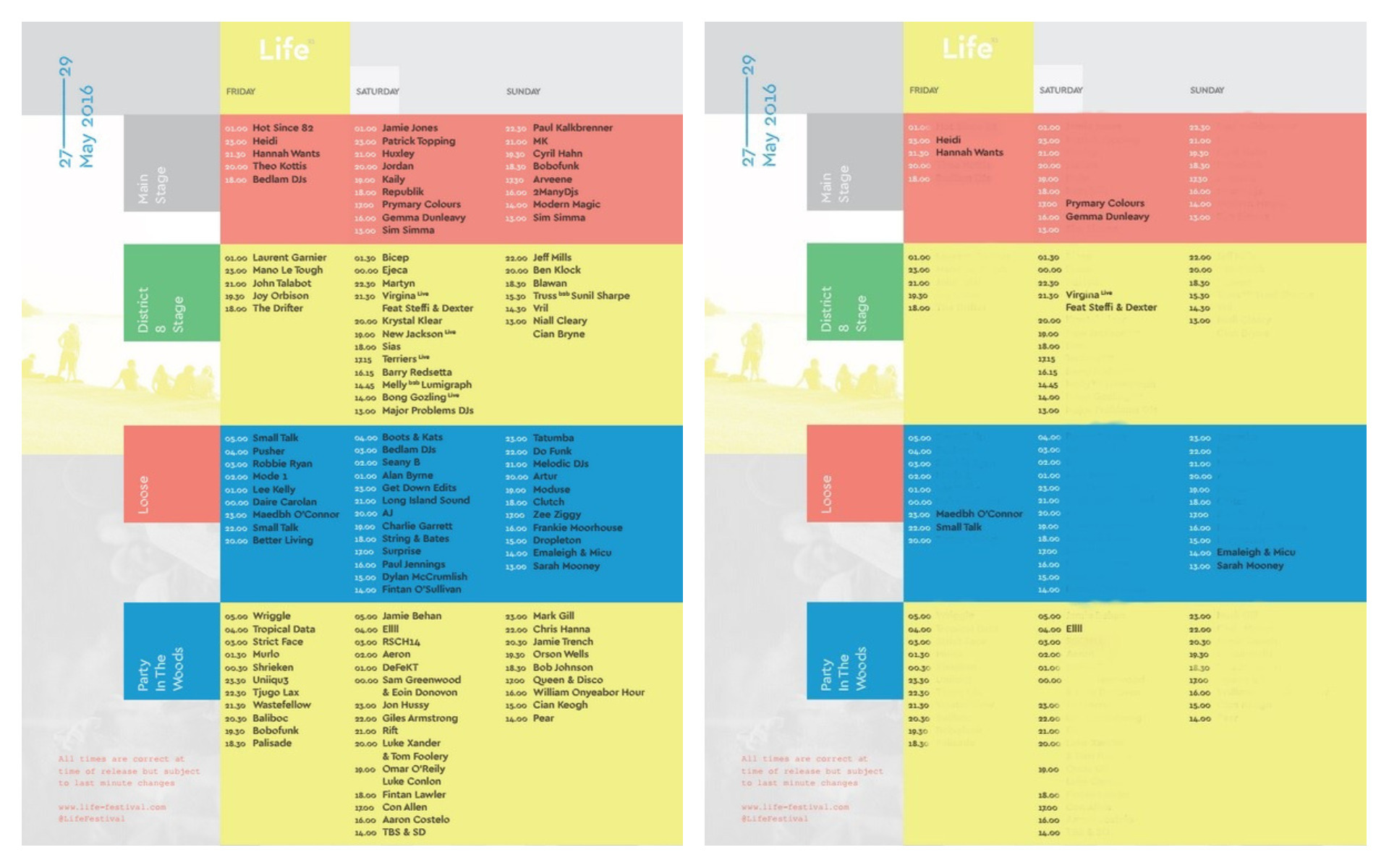In May 2017 I began research for my MA dissertation, Why are there so few female Music Producers? I spent three months interviewing female members of the music industry in Ireland, and also researching gender in music magazines. Since August, I’ve been adapting the research into a series of articles. This article is the first, and outlines how the initial research question was transformed by what I found, and some thoughts about female visibility in the music industry, and an environment which may be hostile to women.
UPDATE: Research from this dissertation has since been published in the peer reviewed journal, Irish Communications Review. Download the paper here: https://arrow.tudublin.ie/icr/vol17/iss1/5/
***
It is a question that has been doing the rounds for years — where are the female headliners? Where are the female producers, conductors, record label owners? At the top levels of the music industry, where are the women?
It’s a question worth asking, and definitely one worth answering. In case there is anyone with lingering doubts as to whether or not women actually are underrepresented in the industry, here are some figures.
Research by the Huffington Post found that in ten popular music festivals over five years, the line ups were consistently male dominated. All-male acts occupied at least 66% of the line ups, with this figure reaching over 80% in some cases. All-female acts remained below 20%, with mixed gender acts faring little better.
In 2015, The Independent UK altered the Reading and Leeds line up to only include acts that featured women. That’s nine acts in total.

If you apply the same process to the Body and Soul 2016 line up, you also end up with a lot of empty space.

The most recent FACTS study by female:pressure surveyed 133 festivals in 34 countries from 2015 to mid-year 2017. On average, 14% of the acts were women, 79% were men, and 7% were mixed gender acts. The figures show a slight increase in female representation and a slight decrease in male representation, yet at the majority of these festivals women linger under the 15% mark.
It has been estimated that less than 5% of music producers are women. Up until 2016, six women had been nominated for the Producer of the Year, non-classical award in that category’s forty year history at the Grammys, and a woman has yet to win the award.
From research I conducted for my dissertation, Why are there so few female Music Producers?, within a representative sample of 323 randomly selected covers of Magazine A*, and 430 randomly selected covers of Magazine B* that feature men and women associated with the music industry, women feature on 60 and 82 of these covers respectively — that’s less than 20% in both publications.
UPDATE: the magazine research discussed here since been published by the Irish Communication Review and can be downloaded here: https://arrow.tudublin.ie/icr/vol17/iss1/5/
CITATION: Kiely, Yvonne (2020) “Music Magazines and Gendered Space: The Representation of Artists on the Covers of Hot Press and Rolling Stone,” Irish Communication Review: Vol. 17: Iss. 1, Article 5.
In the same research I also looked into the gender make-up of two of Ireland’s major music festivals; the electronic music festival Life, and the mixed genre festival Body and Soul. In 2016 and 2017, less than 16% of acts featured women, and women accounted for less than 13% of the performers at Life. The figures are a lot better for Body and Soul, where in the same years less than 26% of performers were women, and women featured in about 40% of the acts. Some of the data from this research is illustrated below.


Women only get a small bite of the donut, which is saying a mouthful.
Gender, and the different realities of the music industry
We do see successful women in the industry; according to NME, four out of five of the top five highest paid musicians of 2016 were women. In 2014, for the first time in its 56 year history, women occupied the Billboard Top 5 for six consecutive weeks. Solo women are challenging the status quo in the charts — but this is a phenomenon that seems to be limited to performers, and pop music singers within a genre that is historically stereotyped as female and feminine. And it appears to have lost some of its momentum. Probe a little deeper and you’ll find that a female pop stars’ freedom is limited, and their careers face rigid and reductive gender norms that have the potential to put them on a predictable, stylised career path. What is clear, is that gender has a big part to play in the music industry.
In my research I investigated the levels of the industry where women are said to be absent, or almost entirely absent. This research involved the content analysis I mentioned earlier, but a much larger part of it was made up of face-to-face interviews with six women who work in occupations where they are a minority — in music composition, music production, DJing, music production lecturing, and in record label management. I had known already that gender was an issue in the music business, and by the end of the research I became certain that there is still far more to uncover. The general consensus is that ‘women are so few’. This is not entirely accurate.
When looking at gender in chart music, we look at who occupies a certain number of places, usually the top five or the top ten. When we speak about gender representation at music festivals, we use percentages to illustrate the facts. We look at the posters and line ups, and display gender as either an absence or a presence on this image. In the data I illustrated earlier in this article, I used a donut chart to show gender as an occupation of area on this shape. In the way we speak about gender in the music industry, we very often speak about it as an occupation of space. This is also true a host of other subjects, such as homelessness and employment — people occupy a certain fraction of the entire donut. A conclusion that this research makes is that the space we imagine when we speak about the music industry is itself gendered. If this is true, then the figures we use to illustrate gender in the music industry — the figures we read about in articles and magazines — are very possibly not indicative of reality, but indicative of another, widely available reality.
Gendered space in the music industry and in social life
What I found incredibly interesting about conducting this research, were the points where the same topics arose, unprompted among different interviewees. This was significant, and it allowed me to focus my attention on several key topics of inquiry into the underlying causes of gender inequality in the music industry. There were several findings drawn from this research, and when investigating women’s minority status within the music industry I feel that one of these findings in particular has a direct influence on how many women we see in the globally recognised music industry.
“Women in this industry are set apart from men, in the media space, in genre, in industry events, in backstage spaces, in performance spaces, in studio spaces, and in public spaces.’’ (from Why are there so few female Music Producers?)
The research told me that men and women who work in the music industry have very different experiences, and most of the women I interviewed brought up the topic of gendered space in a variety of contexts. Gendered space is a concept and area of study that examines the physical separation of men and women, or different genders, and significantly for this research, the spatial relations that inhabit different areas in society. It also describes the appropriate — or socially accepted — organisation and expression of gender in spaces of society. Public bathrooms are gendered spaces, and where we can see a change in our concept of gendered space in these particular areas is the introduction of gender neutral bathrooms over recent years.

The women I interviewed spoke about gender, and in particular women’s gender, existing in a different realm of experience to the male gender in a multitude of physical spaces within the music industry. These women spoke from first hand experience about certain spaces of the industry which act as hot beds for the differential and discriminatory treatment of women. They also spoke about certain spaces allowing for the cultivation and conservation of an objectifying discourse around women in music, that both misrepresents their relationship to the industry, and renders them a target for non-consensual physical contact and verbal derogation from others. In this research, it was the male gender that the women related their negative experiences and observations to.
There is a lot to digest in those previous statements. While it would be worthwhile speaking in detail about what each interviewee said about gendered space, for the purposes of respecting their right to anonymity this article will take a broad look at what they said about gendered space and the music industry.
The music industry is divided into lots of different spaces that are all part of one heterogeneous unit. One woman spoke about back stage spaces. She spoke specifically about the ‘groupie’ stereotype, and how this decades old, culturally embedded assumption about women in music still has a strong presence in the industry today. Another woman spoke about industry events being gendered spaces where women are not visible. One woman spoke about studios being very male spaces that are sometimes visibly hostile to women with their decoration, and some men in these spaces being patronising in how they speak to non-male producers. The topic of studios was brought up by another woman who spoke about facing a wave of male energy that affects interactions upon entering these spaces. One woman had a particularly terrible experience with a male sound engineer, within a technological space, taking over her own work.
The media landscape, and the language used by some music journalists was also described as gendered. Performance spaces were discussed. As were public spaces. It was particularly disturbing listening to some women speak about their experiences in public spaces. They spoke about men touching their bodies, saying derogatory things to them, and expressing an entitlement to non-consensual physical contact within these spaces.
The discussions I had with these women were at times very exposed, and I felt privileged to be given access to these personal experiences. For that, I’d like to again say thank you to them.
It’s more a question of visibility than absence
I ended up investigating gender visibility in the music industry.
The end of the research ended up making me reevaluate the initial question. It was the articles and academic discussions about the figure of ‘less than 5%’ that acted as the springboard into this research. However, one key finding was that asking “why are there so few female music producers?” is the wrong question to ask. That less than 5% figure does not entirely compute with the evidence. The question to consider next time is “why do we see so few female music producers?”.
“There is a limiting of space in the industry where women can be visible in positions of musical control” (from Why are there so few female Music Producers?).
That’s the music industry as we know it, as the big thing that is all encompassing of ‘the business’. During the year I was thinking about this question, and the during the months I spent researching through interviews and content analysis, my knowledge of female music networks grew much larger.

Among one of the groups I became more familiar with was female:pressure, and I signed up as a registered member. Female:pressure is a global online music network for female identifying artists, producers, researchers, organisers, and journalists within the world of electronic music. There are at least 9,000 people in this network, and the system makes it very easy for members to communicate across countries and continents. Over the last year I’ve been very fortunate to be one of these women. While this experience has been incredibly empowering and comforting, being part of this global conversation has also given me greater depth of sight into the effects of an unequal industry environment.
When a person is routinely faced with inequitable barriers to progression, discrimination, and abuse in the spaces and pathways of their professional careers, then very often they will find another path. One interviewee spoke specifically about women and men in the music industry travelling on two different career paths, with women facing more obstacles and less certain terrain. There are several factors to consider here. One factor is visibility in the music industry. What we see men doing. What we see women doing. The well worn paths, and the visible, established checkpoints to success. The helping hands, and accessible opportunities. In the content analysis I conducted, male members of the music industry are more than four times more likely to appear on music magazine covers than female members over the entire history of the magazines that were investigated. And when female members do appear, they tend to embody a much difference presence to their male counterparts, in their appearance and their body language. That media space is gendered. In the same way that other spaces discussed earlier are gendered. Very often in visual music media, the terms of visibility are set out, which create a narrow space for the expression of gender and identity.
The structural inequalities in the music industry – the combined gendered spaces being one part of these – affect the experiences of artists, of all genders in these environments. Female music networks are in part a reaction to these inequalities, these negative experiences and inequitable barriers. They are a space with a different environment and different structures. A different kind of gendered space. Female identifying artists can reach out to each other for gigs, festivals, meetings, conferences and research. The concept of gender is also part of the conversation, as something that is not decisive or determinate. These spaces exist on a global scale – not as visible as the industry spaces we are presented with on a day-to-day basis – as an evolving music industry that is built on different structures, principles and social capital. These networks actively recognise the deficits of the widely established music industry, and the inequalities that are interwoven into its practices. They make an effort to readdress these problems with positive discrimination, transparency, global coordination, open discussions and equal opportunities. They are creating a path for female artists that exists in its own right, and not one that faces the options of measuring itself through comparisons to male artist’s careers, or the dominant models presented by the industry.
I did not complete this research on my own
The research I conducted led me to several findings, each of which serve to give a greater understanding of the part gender has to play in the music industry. The effects of gender are described in its findings, and specifically in terms of gender equality. During the interviews I conducted, I felt the weight of these women’s words when they discussed their experiences in different spaces in their professional lives. I was silent and I listened. Gendered space stood out to me, as an important issue that needs to be discussed when we consider gender equality in the music industry, and when we discuss the experiences of women in wider society. In this article I discuss the relationship between female visibility and the environment of the music industry. Crucially, the cultivation of networks and spaces by female identifying artists.
I’m aware that this is one piece of research, my own analysis, and my own conclusions on gender in the spaces that artists occupy. What gives me confidence in the conclusions that I’ve drawn are my experiences of speaking to women and listening to women; asking them about their careers, and giving them the opportunity to speak uninterrupted. Through allowing them to guide my inquiry, alongside my own understanding. It’s a work in progress with no end in sight, but certainly a step forward.

Leave a comment